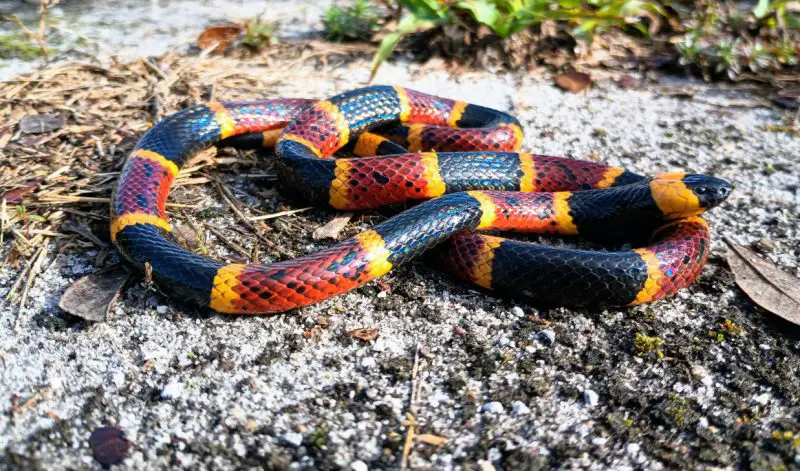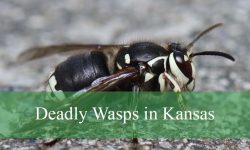Coral snakes in South Carolina stand out as some of the most intriguing and least understood reptiles in the region. These snakes lead quiet, hidden lives beneath pine needles, sandy soil, fallen logs, and the loose litter that carpets longleaf pine forests. Their color bands—red, yellow, and black arranged in a striking sequence—are instantly recognizable, yet sightings remain rare due to their cautious and secretive behavior. Despite their vivid appearance, coral snakes avoid confrontation, slipping beneath debris or burrowing into soft sand rather than engaging potential threats.
South Carolina’s coastal plain, sandhills, and longleaf pine ecosystems provide ideal habitat for coral snakes, supporting their need for loose substrate, stable temperatures, and abundant prey. Their biology is shaped around stealth, restraint, and a venom system that is far more specialized than many people realize. Unlike pit vipers, coral snakes rely on neurotoxic venom and a fixed-fang system that requires a very different approach to both hunting and defense.
Below are seven detailed insights into coral snakes in South Carolina that reveal their biology, behavior, and ecological significance in ways that most people never hear about.
1. Coral Snakes in South Carolina Use a Powerful Neurotoxic Venom System

Their Venom Targets the Nervous System Rather Than Tissue
Coral snakes in South Carolina rely on a venom system that works very differently from the hemotoxic venom found in pit vipers. Instead of destroying tissue or causing widespread swelling, their venom interferes with the electrical communication between nerves and muscles. When a coral snake bites a small reptile or amphibian, the venom begins to disrupt the nervous system almost immediately, even though nothing appears unusual on the surface. A skink or small snake may continue crawling for several moments, unaware that the paralysis process has already started deep within its body.
This hidden effect is one of the reasons coral snake bites are so easily underestimated. The venom does not draw attention through pain or bruising. Instead, it quietly shuts down the prey’s ability to move, breathe, and coordinate muscles. Within minutes, the prey becomes noticeably slower, often moving erratically before finally losing the ability to control its body at all.
The entire process is internal, silent, and incredibly efficient.
Neurotoxins Work With Precision
Neurotoxic venom takes more biological energy to produce, so coral snakes deploy it with remarkable restraint. Their venom contains finely tuned α-neurotoxins that attach to acetylcholine receptors at the neuromuscular junction, preventing nerves from telling muscles what to do. For the snake, this precision is a major advantage. It allows a small predator to take down surprisingly agile prey without relying on strength or speed.
Every component of the venom has a purpose. The toxins are structured to bind to very specific receptors, and even a small amount can disable a prey animal completely. Because the venom does not cause immediate pain or swelling, the animal does not panic or flee aggressively. This keeps the struggle minimal and reduces the chance of attracting larger predators.
The venom’s sophistication reflects millions of years of evolutionary fine-tuning.
Human Symptoms Can Be Delayed
One of the most misunderstood aspects of coral snake venom is its delayed effect on humans. A person bitten may not feel significant pain, and the absence of obvious swelling often creates a false sense of safety. Hours can pass before neurological symptoms become noticeable—drooping eyelids, muscle weakness, difficulty speaking, or shallow breathing.
By the time symptoms appear, the neurotoxins have already interfered with nerve function. This is why medical treatment must be sought immediately, regardless of how harmless the bite feels at first.
The danger lies in the quiet, progressive disruption of the nervous system.
2. Their Fixed-Fang Venom Delivery Requires Close, Precise Biting
Coral Snakes Cannot Inject Venom the Way Pit Vipers Do
Rattlesnakes and copperheads use long, hinged fangs that swing forward when they strike, injecting venom instantly. Coral snakes lack this mechanism. Their fangs are short and fixed in place, which means they cannot deliver a rapid, open-mouthed stab. Instead, they often anchor themselves to the prey and work the venom in through repeated pressure, almost like chewing.
This anatomical limitation shapes their behavior. Quick defensive strikes are not effective for coral snakes, so they avoid them. Their venom system is designed for close contact with small prey, not long-distance defense against large threats.
Prey Size Determines Bite Strategy
Because their fangs are small, coral snakes primarily target thin-bodied prey such as small snakes, skinks, glass lizards, and salamanders. The shape and size of such prey allow the coral snake to attach effectively and maintain contact long enough for the neurotoxins to act.
Coral snakes typically aim for the head, neck, or upper body. These regions allow venom to reach nerves and the central nervous system quickly.
Precision is essential, and the snake’s entire approach—slow, careful, methodical—reflects this need.
Defensive Bites Are Rare But Serious
Coral snakes are shy and avoid confrontation whenever possible. A defensive bite usually happens only when a person picks up the snake, pins it down, or accidentally steps on it. If the snake does bite defensively, it may hold on longer than a pit viper, increasing the chances of envenomation.
Even so, most encounters end without a bite.
Avoidance—not aggression—is the foundation of their behavior.
3. Coral Snakes in South Carolina Are Masters of Camouflage Despite Bright Colors
Their Color Pattern Isn’t Designed Primarily for Hiding
Coral snakes are famous for their red, yellow, and black bands, and many people assume such bright colors must make them easy to spot. In reality, these contrasting bands break up the snake’s outline when it moves through patchy light. In longleaf pine forests, sunlight filters in narrow beams across a dim forest floor. The scattered light makes the coral snake’s bands blend into shifting patterns of shadow and color.
In motion, the snake becomes surprisingly hard to follow. Even predators with sharp vision struggle to track the moving pattern.
Their Colors Serve as a Warning Signal
The coral snake’s color pattern also serves as a warning system. Predators instinctively avoid red-yellow banding once they have learned its meaning—even if the lesson comes from confronting a harmless mimic. Scarlet kingsnakes and certain milksnake morphs use this mimicry to their advantage, adopting similar color patterns to deter predators.
This visual warning means coral snakes rarely need to defend themselves with venom.
Predators learn quickly and avoid repeating mistakes.
Stillness Reinforces Their Defense Strategy
When disturbed, a coral snake often freezes completely. Combined with its disruptive coloration, stillness makes the snake even harder to locate, especially when partially hidden under leaf litter or pine needles.
In many cases, a person may be only a few feet away without ever noticing the snake.
Stillness is one of their most effective survival tools.
4. South Carolina’s Sandhills and Coastal Plains Create Ideal Habitat
Loose, Sandy Soil Supports Burrowing
The Sandhills region of South Carolina is characterized by dry, sandy ridges and rolling terrain. Coral snakes thrive here because the soil allows them to burrow easily, slip beneath the surface, or retreat quickly when threatened. Sandy soils also reduce moisture loss and help regulate body temperature in the heat of summer.
Most of a coral snake’s daily movement happens just under the surface, hidden from sight.
Longleaf Pine Ecosystems Offer Abundant Cover
Longleaf pine forests create a deep, fluffy carpet of needles that retains moisture and provides excellent insulation from heat. Coral snakes use these layers as tunnels, shelters, and ambush points. The needles protect the snake from predators while maintaining a stable microclimate.
The ground layer of a longleaf pine forest is a world of its own, rich with insects, amphibians, and reptiles.
Wetlands and Moist Creek Edges Provide Prey
Much of the coral snake’s prey—skinks, salamanders, frogs, and small snakes—concentrate around wet or damp habitat edges. Because South Carolina’s landscape alternates between dry ridges and humid lowlands, coral snakes benefit from a diverse assortment of prey and shelter.
This habitat mosaic is one of the reasons coral snakes persist across coastal and inland regions alike.
5. Coral Snakes Show Remarkable Restraint and Avoid Confrontation
They Try to Flee Before Biting
Coral snakes are extremely reluctant to bite in defense. When threatened, their first instinct is to disappear—into holes, beneath logs, or under leaf litter. Their entire survival strategy revolves around staying unseen, not fighting.
A coral snake that remains undetected lives longer than one that engages a threat.
They Use Tail Displays Before Biting
If escape is blocked, coral snakes sometimes raise and wave their tail to confuse predators. The tail mimics the head in movement and coloration, causing predators to strike the wrong end. This behavior buys the snake critical seconds to escape.
This is one of the few defensive displays the coral snake uses consistently.
They Rarely Display Aggression Toward Humans
Because their defense strategy is based on concealment, not intimidation, coral snakes do not hiss, rattle, flatten their bodies, or bluff-strike like pit vipers. Most humans who encounter one see only a quick retreat into debris.
A coral snake’s goal is to avoid being noticed at all.
6. They Are Elusive Hunters That Specialize in Reptilian Prey
Their Primary Prey Includes Other Snakes
Coral snakes frequently eat small snakes such as worm snakes, ringneck snakes, and juvenile racers. Their venom is particularly effective on reptiles, making them well-adapted snake specialists. This diet influences reptile populations and shapes food web dynamics.
Small snakes are abundant in South Carolina’s pine forests, giving coral snakes reliable hunting opportunities.
They Also Eat Lizards and Amphibians
Coral snakes consume a variety of skinks, salamanders, and occasionally small frogs. They detect prey through chemical cues instead of sight, probing leaf litter and soil with their tongues to pinpoint hidden animals.
They thrive in warm microhabitats where these prey species concentrate.
Their Foraging Behavior Is Slow and Methodical
Instead of ambushing prey, coral snakes move slowly across the forest floor, poking their heads into holes and beneath debris. Their movements are careful and deliberate, reflecting the need to maintain control during close-contact predation.
This hunting method is shaped by their anatomy and fossorial lifestyle.
7. Coral Snakes in South Carolina Are Rarely Seen, Leading to Many Misidentifications
Most Sightings Are Actually Kingsnakes
Because coral snakes are so elusive, most reported sightings end up being scarlet kingsnakes or colorful milksnake morphs. These mimics share the same red, yellow, and black pattern but lack venom. Their abundance contributes to widespread confusion.
Many reports of “coral snakes” come from areas where true coral snakes are extremely rare.
Coral Snakes Spend Much of Their Lives Underground
Coral snakes are fossorial, meaning they spend most of their time underground or beneath leaf litter. They surface mainly during warm mornings, after rains, or when seeking mates. Even experienced herpetologists can go years without seeing one in the wild.
Their secretive lifestyle makes them one of the most difficult reptiles to study in South Carolina.
Their Elusiveness Enhances Their Mystique
Because sightings are so rare, myths and exaggerations spread easily. In reality, coral snakes simply want to be left alone. Their venom is potent, but their behavior is remarkably gentle and retiring.
Their mystery comes not from danger, but from absence.
FAQs About Coral Snakes in South Carolina
Are coral snakes common in South Carolina?
They are present but rarely seen due to their secretive, underground habits.
How dangerous is a coral snake bite?
Serious but extremely uncommon; their neurotoxic venom requires prompt medical attention.
What do coral snakes eat?
Small snakes, lizards, amphibians, and occasionally insects or nestling reptiles.
How can I tell coral snakes from mimics?
Coral snakes have red touching yellow bands, while mimics typically have red touching black.
Do coral snakes chase people?
No, they rely on hiding and retreat rather than pursuit.
Where are coral snakes usually found?
Sandy soils, longleaf pine forests, coastal plains, and wetland edges.
Do coral snakes climb?
They can climb slightly but spend most of their lives on or under the forest floor.
Conclusion
Coral snakes in South Carolina represent a unique and highly specialized group of reptiles whose behaviors and biology often remain hidden beneath the forest floor. Their neurotoxic venom, cautious temperament, fossorial movement, and striking coloration reveal a snake that depends on stealth and precision rather than aggression. Although rarely seen, their presence supports ecological balance by influencing small reptile populations and contributing to the natural dynamics of the state’s longleaf pine ecosystems.
Understanding their habits helps dispel myths and encourages a deeper appreciation for one of South Carolina’s most remarkable, elusive residents. Far from being the frightening creature of folklore, the coral snake is a carefully adapted animal quietly shaping the forests and sands of the Southeast.






